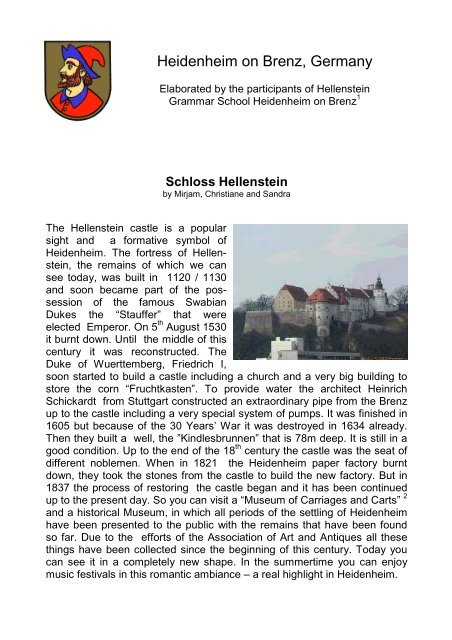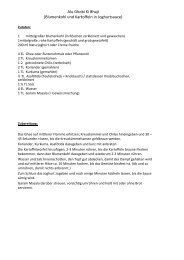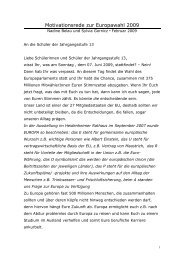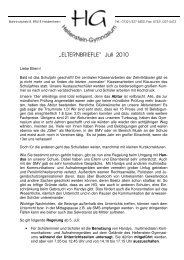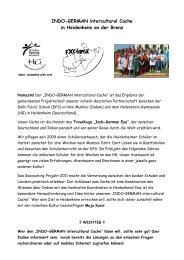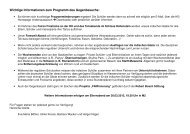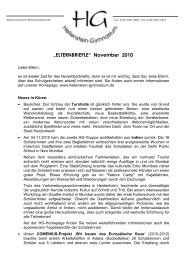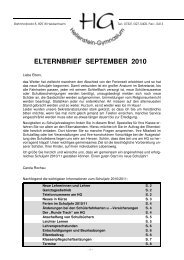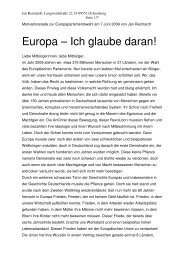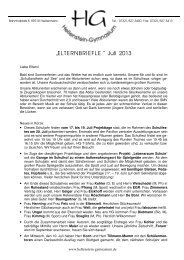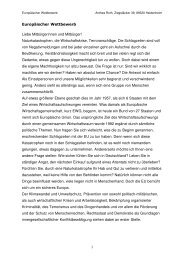Heidenheim on Brenz, Germany - Hellenstein-Gymnasium ...
Heidenheim on Brenz, Germany - Hellenstein-Gymnasium ...
Heidenheim on Brenz, Germany - Hellenstein-Gymnasium ...
Create successful ePaper yourself
Turn your PDF publications into a flip-book with our unique Google optimized e-Paper software.
<str<strong>on</strong>g>Heidenheim</str<strong>on</strong>g> <strong>on</strong> <strong>Brenz</strong>, <strong>Germany</strong><br />
Elaborated by the participants of <strong>Hellenstein</strong><br />
Grammar School <str<strong>on</strong>g>Heidenheim</str<strong>on</strong>g> <strong>on</strong> <strong>Brenz</strong> 1<br />
Schloss <strong>Hellenstein</strong><br />
by Mirjam, Christiane and Sandra<br />
The <strong>Hellenstein</strong> castle is a popular<br />
sight and a formative symbol of<br />
<str<strong>on</strong>g>Heidenheim</str<strong>on</strong>g>. The fortress of <strong>Hellenstein</strong>,<br />
the remains of which we can<br />
see today, was built in 1120 / 1130<br />
and so<strong>on</strong> became part of the possessi<strong>on</strong><br />
of the famous Swabian<br />
Dukes the “Stauffer” that were<br />
elected Emperor. On 5 th August 1530<br />
it burnt down. Until the middle of this<br />
century it was rec<strong>on</strong>structed. The<br />
Duke of Wuerttemberg, Friedrich I,<br />
so<strong>on</strong> started to build a castle including a church and a very big building to<br />
store the corn “Fruchtkasten”. To provide water the architect Heinrich<br />
Schickardt from Stuttgart c<strong>on</strong>structed an extraordinary pipe from the <strong>Brenz</strong><br />
up to the castle including a very special system of pumps. It was finished in<br />
1605 but because of the 30 Years’ War it was destroyed in 1634 already.<br />
Then they built a well, the ”Kindlesbrunnen” that is 78m deep. It is still in a<br />
good c<strong>on</strong>diti<strong>on</strong>. Up to the end of the 18 th century the castle was the seat of<br />
different noblemen. When in 1821 the <str<strong>on</strong>g>Heidenheim</str<strong>on</strong>g> paper factory burnt<br />
down, they took the st<strong>on</strong>es from the castle to build the new factory. But in<br />
1837 the process of restoring the castle began and it has been c<strong>on</strong>tinued<br />
up to the present day. So you can visit a “Museum of Carriages and Carts” 2<br />
and a historical Museum, in which all periods of the settling of <str<strong>on</strong>g>Heidenheim</str<strong>on</strong>g><br />
have been presented to the public with the remains that have been found<br />
so far. Due to the efforts of the Associati<strong>on</strong> of Art and Antiques all these<br />
things have been collected since the beginning of this century. Today you<br />
can see it in a completely new shape. In the summertime you can enjoy<br />
music festivals in this romantic ambiance – a real highlight in <str<strong>on</strong>g>Heidenheim</str<strong>on</strong>g>.
The Organ<br />
The “Pauluskirche“<br />
A Protestant Church in the Centre of <str<strong>on</strong>g>Heidenheim</str<strong>on</strong>g>.<br />
by students of the forms 10b and 10c<br />
The Architectural Style. The “Pauluskirche”<br />
in <str<strong>on</strong>g>Heidenheim</str<strong>on</strong>g> was built between 1895 and<br />
1898 during the new Gothic period. It was financed<br />
by important foundati<strong>on</strong>s of <str<strong>on</strong>g>Heidenheim</str<strong>on</strong>g><br />
citizens and designed by Felix v<strong>on</strong> Bremer,<br />
an architect from Stuttgart. The “Pauluskirche”<br />
is a w<strong>on</strong>derfully maintained example<br />
of a new Gothic church.<br />
In 1898 the “Link” organ was inaugurated<br />
together with the “Pauluskirche”. It had 34<br />
organ stops. In the course of time it was redesignedseveral<br />
times.<br />
When plans<br />
for the restorati<strong>on</strong><br />
of the church were made in the 1980s<br />
a new organ was planned, too. In 1992 an<br />
order for a completely new organ was given<br />
to “Rieger Organs”. With the inaugurati<strong>on</strong> of<br />
the new organ at Whitsun in 1999 the<br />
restorati<strong>on</strong> of the new church was completed.<br />
The new organ has 40 organ stops.<br />
The Bells. The church has got four bells,<br />
which, in the course of time, were often<br />
required to produce weap<strong>on</strong>s in wars. Every<br />
bell has got its own name and relief.
The “Knöpfleswäscherin“<br />
by Sabrina and Antje<br />
The “Knöpfleswäscherin”, a woman<br />
who is washing “Knöpfle”, is a legend<br />
and a landmark of <str<strong>on</strong>g>Heidenheim</str<strong>on</strong>g>. In the<br />
year 1984 a br<strong>on</strong>ze statue of a<br />
“Knöpflewäscherin” which serves as a<br />
well, was built in fr<strong>on</strong>t of the old town<br />
hall, called “Elmar-Doch-Haus”. Here<br />
are the two legends:<br />
1 st Legend:<br />
Once up<strong>on</strong> a time, a woman wanted to<br />
bring her husband “Knöpfle“, a typical<br />
meal, in a basket to his workplace. On<br />
the way she stumbled over a st<strong>on</strong>e and<br />
woman and basket fell to the ground.<br />
The “Knöpfle“ rolled away into the filth<br />
of the street. The woman from<br />
<str<strong>on</strong>g>Heidenheim</str<strong>on</strong>g>, however, wasn’t stupid at<br />
all. She collected the “Knöpfle“ in no The "Knöpfleswäscherin"<br />
time, and put them back into her<br />
basket. Then she hurriedly went to the River <strong>Brenz</strong> where she washed<br />
them. A stranger was watching her from a distance. From then <strong>on</strong><br />
<str<strong>on</strong>g>Heidenheim</str<strong>on</strong>g>ers are often lovingly referred to as : "Knöpflewäscher"!<br />
2 nd Legend<br />
During the “Thirty Years’ War“ French soldiers disliked the “<str<strong>on</strong>g>Heidenheim</str<strong>on</strong>g>er<br />
Knöpfle“ and dropped them to the floor al<strong>on</strong>g with the bowl. The proprietor<br />
of the restaurant washed them in the nearby river “Wedel”, fried them<br />
afterwards and served them to the guests. It is reported that the soldiers<br />
liked the “Knöpfle” very much. (from „<str<strong>on</strong>g>Heidenheim</str<strong>on</strong>g>er Zeitung“ 26/07/1982)<br />
Recipe for yeast Knöpfle<br />
Ingredients: 30 grams of yeast, a pinch of salt<br />
250 ml of milk 50 g of butter<br />
500 grams of flour salt water<br />
a pinch of sugar breadcrumbs<br />
1 egg 30 g of butter<br />
Crumble the yeast and put it into a small bowl with 5 tablespo<strong>on</strong>fuls of<br />
warm milk, 3 teaspo<strong>on</strong>s of flour and a pinch of sugar; stir it all. Let it rise in<br />
a warm place. Put the rest of the milk and the flour into a bowl and add the
egg, salt, butter and the yeast dough. Knead everything into a mixture.<br />
Cover the dough with a piece of cloth and let it rise for about 15 minutes.<br />
Now form 8-10 dumplings, which you leave in a warm place to rise <strong>on</strong>ce<br />
again, let them simmer gently for about 20 minutes in salt water. Now fry<br />
the breadcrumbs in some butter until they are brown and put them <strong>on</strong> the<br />
Knöpfle.<br />
Yeast-Knöpfle are often served with sauerkraut, beans or lentils.<br />
The <strong>Hellenstein</strong>-<strong>Gymnasium</strong> (HG) 3<br />
by Samuel, Andreas, Jan-Hendrik, Daniel,<br />
Benjamin and Kilian<br />
There are four grammar schools at<br />
<str<strong>on</strong>g>Heidenheim</str<strong>on</strong>g>: Schiller-<strong>Gymnasium</strong>,<br />
Werkgymnasium, Max-Planck-<strong>Gymnasium</strong><br />
and <strong>Hellenstein</strong>-<strong>Gymnasium</strong>.<br />
The <strong>Hellenstein</strong>-<strong>Gymnasium</strong> is the<br />
oldest of the four. The picture <strong>on</strong> the<br />
right shows the old building of it in<br />
the year 1900. In 1956 the building<br />
was enlarged and its appearance<br />
changed. Today about 800 pupils are<br />
studying there.<br />
Chr<strong>on</strong>icle of the <strong>Hellenstein</strong>-<br />
<strong>Gymnasium</strong><br />
1500 Foundati<strong>on</strong> of a Latin School<br />
1834 Foundati<strong>on</strong> of a "Realschule“<br />
1914 First high-school diploma<br />
1955 Enlargement of the school building<br />
1971 First coeducati<strong>on</strong> at this school<br />
1994 New electr<strong>on</strong>ic equipment for the school<br />
1995 Establishment of a science profile<br />
1997 Joining the internet<br />
1999 Establishing Spanish as a third language<br />
2000 Installing a new computer room<br />
Teaching Science,<br />
A very old Traditi<strong>on</strong><br />
by Daniel, J<strong>on</strong>as, Tobias E.<br />
and Tobias S.,<br />
From the foundati<strong>on</strong><br />
of the "Realschule" in<br />
1834 up to now,<br />
teaching science<br />
takes an important<br />
place in our school.<br />
Of course, there are a
lot of very interesting, and beautiful things a child can learn at school. But<br />
there is something else. The history of chemistry for example is a good<br />
less<strong>on</strong> <strong>on</strong> internati<strong>on</strong>ality, especially the history of acids. Scientists from all<br />
over Europe, all over the world have been working <strong>on</strong> the same subject for<br />
centuries, each taking advantage of the findings of his predecessors.<br />
Science is internati<strong>on</strong>al and should serve mankind as a whole.<br />
The <strong>Hellenstein</strong>-<br />
<strong>Gymnasium</strong> today<br />
Results of an<br />
opini<strong>on</strong> poll<br />
We made an opini<strong>on</strong> poll in<br />
<str<strong>on</strong>g>Heidenheim</str<strong>on</strong>g> asking the<br />
following questi<strong>on</strong>:<br />
"Which of the four<br />
grammar schools in HDH<br />
comes into your mind at<br />
this moment?"
The Museum of Art 4<br />
by students of the form 10a<br />
Near our school you can find a very<br />
beautiful building. It dates back to 1903<br />
when the famous architect from Stuttgart,<br />
Philipp Jakob Manz (1861-1936),<br />
designed it. With the help of rich people<br />
of <str<strong>on</strong>g>Heidenheim</str<strong>on</strong>g> the community could<br />
afford a costly building that became a<br />
real treasure of the town. It was meant to<br />
be a bath for all people of <str<strong>on</strong>g>Heidenheim</str<strong>on</strong>g><br />
and it was used for this purpose until<br />
1987.<br />
When the “Aquarena” was built, it<br />
became redundant. So the city-council<br />
decided to restore the magnificent building<br />
in art deco style and use it as<br />
municipal art gallery. They have the<br />
biggest collecti<strong>on</strong> of prints of Picasso<br />
there and <strong>on</strong>e of the best collecti<strong>on</strong>s of<br />
HAP Grieshaber prints. At the moment it<br />
is being renewed to give a better presentati<strong>on</strong><br />
to those collecti<strong>on</strong>s. The<br />
exhibiti<strong>on</strong>s at the “Kunstmuseum” are<br />
highly appreciated by the public because<br />
they are<br />
often combined<br />
with music and<br />
poetry. There are<br />
also special activities<br />
for children<br />
to help them understand art and take up painting<br />
themselves.<br />
Events during the whole night – <strong>on</strong>ce a year – have<br />
always been appreciated by the public. A great<br />
many of the inhabitants of <str<strong>on</strong>g>Heidenheim</str<strong>on</strong>g> seem to be<br />
art-loving people.
Against Prejudice<br />
by Florian and Hans-Jörg<br />
Many people d<strong>on</strong>’t like Germans because of their Nazi past. In <str<strong>on</strong>g>Heidenheim</str<strong>on</strong>g><br />
we have two famous pers<strong>on</strong>s that can help us to get free from simple<br />
sentences.<br />
As a student of <strong>Hellenstein</strong>-<br />
<strong>Gymnasium</strong> we have a special<br />
focus <strong>on</strong> him because<br />
this is the family name of our<br />
former headmaster from 1907<br />
to 1920.<br />
Erwin Rommel 5<br />
Erwin Rommel was born at<br />
<str<strong>on</strong>g>Heidenheim</str<strong>on</strong>g> at 5 Bahnhofstrasse <strong>on</strong> 1891, November 15 th . After the family<br />
had moved he went to school at Schwäbisch Gmünd. Having finished<br />
school Erwin Rommel wanted to work with the Zeppelin factory at<br />
Friedrichshafen, but his father advised him to join the army. At the age of<br />
19 he joined the 7th infantry regiment of Württemberg, and fought in the<br />
First World War, in which he was promoted to captain. Moreover he<br />
received the highest German military decorati<strong>on</strong> of ‘Pour le Mérite’.<br />
In the Sec<strong>on</strong>d World War he was the first to lead Hitler’s headquarters.<br />
During the invasi<strong>on</strong> of France he was commander of a tank divisi<strong>on</strong>. Having<br />
shown his tactical and strategic skills he was sent to North Africa to lead the<br />
German Africa Corps. His defeating the British brought him the nickname<br />
of „Wüstenfuchs (Fox of the Desert)“. When he was defeated in the battle of<br />
El Alamein by the English general M<strong>on</strong>tgomery, he ordered his men to<br />
retreat which was against Hitler’s order that said: „Keep fighting at any<br />
cost“. Back from Africa Rommel became supreme commander of Italy.<br />
Later he became chief of staff of the Atlantic-Walls and was resp<strong>on</strong>sible for<br />
fighting Allied invasi<strong>on</strong> of the c<strong>on</strong>tinent. On July 17th 1944, he was badly<br />
wounded. He realized that the Germans would never be able to win the war<br />
and he let Hitler know. Hitler did not appreciate that and sent Rommel to his<br />
death. He had the choice to kill himself or to appear in Court where his<br />
future had already been decided <strong>on</strong>. So Rommel decided to kill himself. A<br />
few days later he was given an h<strong>on</strong>ourable burial.<br />
Erwin Rommel had never been involved in war crime. His enemies had<br />
great respect for him and said he was the last knight. His name is known in<br />
c<strong>on</strong>necti<strong>on</strong> with the officers that resisted and tried to kill Hitler <strong>on</strong> 20 th July<br />
in 1944.
Georg Elser 6<br />
Two villages near <str<strong>on</strong>g>Heidenheim</str<strong>on</strong>g> claim to be<br />
c<strong>on</strong>nected with Georg Elser: Hermaringen,<br />
he was born there <strong>on</strong> 4th of<br />
January 1903. His father was a farmer<br />
and he also traded in wood. Königsbr<strong>on</strong>n<br />
because his parents moved there after<br />
their marriage in 1904. After school he<br />
started to work at the ir<strong>on</strong> factory there to<br />
become a turner. But because of bad<br />
health he had to stop it two years later.<br />
Then he decided to become a joiner. He<br />
succeeded and was the best of the<br />
youngsters who did their exam. In 1925<br />
he moved to C<strong>on</strong>stance – a city <strong>on</strong> Lake<br />
C<strong>on</strong>stance – were he c<strong>on</strong>structed models for clocks. Those skills should<br />
become very helpful in future times. He also joined a communist workers’<br />
associati<strong>on</strong> there. The Black Friday in October 1929 changed his life. He<br />
tried to get a job in Switzerland. Three years later he came back to his<br />
family. Working at a factory in <str<strong>on</strong>g>Heidenheim</str<strong>on</strong>g> he had the impressi<strong>on</strong> that<br />
military warfare was being prepared for. That made him aware of the<br />
danger involved in the new regime. From November 1938 to November<br />
1939 Elser kept thinking of how to rid <strong>Germany</strong> of the dictator. First he<br />
joined a famous meeting of the most important Nazi fighters at a restaurant<br />
in Munich called “Bürgerbräukeller”. There he watched the procedure and<br />
devised how to realize his idea. Back home he started experiments <strong>on</strong><br />
explosi<strong>on</strong>s. For a short time he worked at a st<strong>on</strong>e factory where he learned<br />
a lot and gathered the things he needed. In August 1939 he moved to<br />
Munich. Now he worked day and night <strong>on</strong> putting his plan into practice. He<br />
went to the restaurant and stayed there until they closed. That way he could<br />
spend the whole night inside preparing <strong>on</strong>e of the big columns to hold the<br />
bomb. His preparati<strong>on</strong>s were finished just in time. So he moved to<br />
C<strong>on</strong>stance where he knew he could cross the border quickly. But the plan<br />
miscarried. The bomb exploded, seven people died and 60 were wounded,<br />
<strong>on</strong>ly the dictator stayed alive and was <strong>on</strong> his way back to Berlin because<br />
due to dense fog Hitler had decided to leave earlier that evening. – Georg<br />
Elser was caught and made pris<strong>on</strong>er at the c<strong>on</strong>centrati<strong>on</strong> camp of<br />
Sachsenhausen. The Nazi Regime could not believe that he had d<strong>on</strong>e that<br />
all al<strong>on</strong>e. They suspected English Intelligence to have used him. But this<br />
was not true. To prepare a big show after the final victory they kept him<br />
alive till 1945. Finally, <strong>on</strong> 9th April he was shot in Dachau. Elser said at the<br />
trial that he had d<strong>on</strong>e it all just to prevent more bloodshed.
Eugen Gaus<br />
by Theresa and Stephanie<br />
Eugen Gaus was born <strong>on</strong> April 28, 1850, in Fridingen, district of Tuttlingen,<br />
in Swabia, <strong>Germany</strong>. Until 1879 he worked as a teacher in Ehingen. After<br />
that Eugen Gaus became headmaster at a sec<strong>on</strong>dary school in Weil der<br />
Stadt. In 1897 he moved to <str<strong>on</strong>g>Heidenheim</str<strong>on</strong>g>.<br />
Eugen Gaus loved archaeology and<br />
geology and started to collect antiquities<br />
in <str<strong>on</strong>g>Heidenheim</str<strong>on</strong>g>. He founded the Museum<br />
of Local History in <strong>Hellenstein</strong> Castle.<br />
Until 1919 he was a very popular teacher<br />
at <strong>Hellenstein</strong> <strong>Gymnasium</strong>. His researches<br />
and excavati<strong>on</strong>s to find out<br />
about the Roman-Alemannic period at<br />
the “Steinheimer Becken” and the “Ries”<br />
(two geologically interesting areas in the<br />
vicinity of <str<strong>on</strong>g>Heidenheim</str<strong>on</strong>g>) have to be<br />
menti<strong>on</strong>ed as well. In the course of<br />
these excavati<strong>on</strong>s Gaus discovered,<br />
am<strong>on</strong>g other things, the cement stocks<br />
of Mergelstetten. He was also active in<br />
the managing committees of various<br />
clubs. He worked in the Associati<strong>on</strong> for<br />
Local History and Ancient Things, which<br />
he had founded, and in the Swabian<br />
Walkers’ Associati<strong>on</strong>. Over the years he<br />
got a number of awards and his work<br />
was highly appreciated.<br />
In 1904, he was awarded the Gold Medal<br />
of<br />
Art<br />
and<br />
Science. From 1922 to his death,<br />
Eugen Gaus was an h<strong>on</strong>orary citizen of<br />
<str<strong>on</strong>g>Heidenheim</str<strong>on</strong>g>. One of the streets and a<br />
sec<strong>on</strong>dary school have been named<br />
after him.<br />
On April 30, 1934, Professor Eugen<br />
Gaus died in <str<strong>on</strong>g>Heidenheim</str<strong>on</strong>g> at the age of<br />
84.
Archaeological Remains in <str<strong>on</strong>g>Heidenheim</str<strong>on</strong>g><br />
and the Surrounding Area 7<br />
Kathrin, Stephanie<br />
The Heidensmithy, Heidenschmiede.<br />
When Hermann Mohn found the Heidensmithy,<br />
his c<strong>on</strong>temporaries learned a lot about<br />
how people lived before their time. The<br />
Heidensmithy lies <strong>on</strong> the southern side of<br />
what is today the castle hill with <strong>Hellenstein</strong><br />
Castle <strong>on</strong> top. Over 5,000 pieces of st<strong>on</strong>e and<br />
more than five kilos of animal b<strong>on</strong>es were dug<br />
up. The finds could be assigned to nearly all<br />
epochs of evoluti<strong>on</strong>. The Heidensmithy was<br />
used as a lookout for hunting and for<br />
temporary accommodati<strong>on</strong>.<br />
Caverns in the L<strong>on</strong>etal Valley<br />
The most famous caverns in the L<strong>on</strong>etal<br />
Valley are the “Bears’ Cave”, the “Hohlenstein<br />
Stadel” and the “Bockstein”. The first<br />
excavati<strong>on</strong>s d<strong>on</strong>e by Oskar Fraas dug out<br />
10,000 b<strong>on</strong>es, am<strong>on</strong>g them 88 skulls and<br />
tools made of flint-st<strong>on</strong>e<br />
too. The tools they found<br />
were from people from the glacial period. Anatomy<br />
professor Robert Wenzel from Wuerzburg dug in the<br />
L<strong>on</strong>etal Valley from 1932 until his death in 1961 and in<br />
the Hohlenstein Stadel. He found pieces of ivory from<br />
the so-called li<strong>on</strong> man that were put together much<br />
later by Joachim Hahn. Later, the “Fohlenhaus” was<br />
studied by Albert Kley and Wolfgang Taute in which<br />
tools made of st<strong>on</strong>e from<br />
the Middle St<strong>on</strong>e Age<br />
were found.<br />
The Li<strong>on</strong>-Man 32<br />
thousand years old,<br />
found at Hohlenstein<br />
Stadel<br />
The little Wild Horse<br />
32 thousand years<br />
old, found at<br />
Vogelherdhoehle
The settling of <str<strong>on</strong>g>Heidenheim</str<strong>on</strong>g><br />
by Felix, Martin, Jürgen, Dominic and Max<br />
In the Br<strong>on</strong>ze and Ir<strong>on</strong> Ages (appr. 2.000-50 BC), the beginning of<br />
c<strong>on</strong>tinuous settlement started (from about 1300 BC). Many remains found<br />
in the area of “Seewiesen” go back to that period. Mounds prove that the<br />
Celts lived there about 800-500 BC.<br />
In Roman Times (appr. 90-260 BC), when<br />
the Roman fr<strong>on</strong>tier wall was expanded by<br />
Emperor Domitian the Romans built a<br />
"Castrum" at the place of today’s<br />
<str<strong>on</strong>g>Heidenheim</str<strong>on</strong>g>. In the middle of the 2 nd<br />
century the "Castrum" was moved to Aalen<br />
but <str<strong>on</strong>g>Heidenheim</str<strong>on</strong>g> still remained an important<br />
place.<br />
The fall of Roman <str<strong>on</strong>g>Heidenheim</str<strong>on</strong>g> began with<br />
the attack of the Alemannic people in 233<br />
BC and ended with the destructi<strong>on</strong> of the<br />
town in 260 / 259 BC.<br />
Roman objects of br<strong>on</strong>ze<br />
In fr<strong>on</strong>t of the <strong>Hellenstein</strong>- <strong>Gymnasium</strong><br />
the pavement shows the<br />
places of the external wall and<br />
towers of the roman fortificati<strong>on</strong>. A<br />
memorial plate <strong>on</strong> the building<br />
explicates it.<br />
The Middle Ages and the time of migrati<strong>on</strong> of people followed. Between<br />
1100 and 1150 the castle was built. Since 1190 the c<strong>on</strong>structi<strong>on</strong> of an<br />
urban defence system was started. From 1330 <str<strong>on</strong>g>Heidenheim</str<strong>on</strong>g> showed<br />
municipal character; in the days of Charles IV, in 1356, the market rights of<br />
<str<strong>on</strong>g>Heidenheim</str<strong>on</strong>g> were c<strong>on</strong>firmed. At that time <str<strong>on</strong>g>Heidenheim</str<strong>on</strong>g> c<strong>on</strong>sisted of a fr<strong>on</strong>t<br />
lane, which served as a market place. A back lane, which served as a<br />
residential quarter and a small industrial area, the so called<br />
“Schmelzofenvorstadt”. Between 1449 and 1462 <str<strong>on</strong>g>Heidenheim</str<strong>on</strong>g> was heavily<br />
affected by wars, at that time <str<strong>on</strong>g>Heidenheim</str<strong>on</strong>g> c<strong>on</strong>sisted of about 70 houses<br />
with 400-500 inhabitants; the urban defence system, including the city wall,<br />
was completed at that time, too.
Museum in the Roman Bath “Römerbad”<br />
by Markus, and Alexander<br />
<str<strong>on</strong>g>Heidenheim</str<strong>on</strong>g> was an important road juncti<strong>on</strong>. At about 90 AD<br />
an important military base was built.<br />
One of the buildings of the military base was a small fort. It<br />
was designed for a thousand riders and covered an area of<br />
520 m². Remnants of it can still be found in the city centre:<br />
The settlement in the area of “<strong>Brenz</strong>-, Paulinen-, Bahnhof-<br />
and Karlsstrasse”. So some of them are under the school<br />
building. <str<strong>on</strong>g>Heidenheim</str<strong>on</strong>g>, was the most important settlement of<br />
the mountain range called “Schwäbische Alb”. This settlement existed until<br />
300 after Christ. It may have been quite an important centre of civil<br />
government, after the soldiers had moved to Aalen in 150 A.D. to defend<br />
their territory at the New Limes 20 km away from home.<br />
HISTORY: The first remains have been discovered by Eugen Gaus in 1903.<br />
During the 20s and 30s he and Kurt Bittel and Hermann Mohn found more<br />
remains. Excavati<strong>on</strong>s started again in 1973/74. But systematic excavati<strong>on</strong>s<br />
did not start before the new post office was being built. Well preserved<br />
Roman remains had been found and building had to be stopped.<br />
Between 1980 and 1981 this area was examined more closely and very<br />
carefully in order not to do any damage to further interesting remains. They<br />
proved, that in the ground there were remains of a Roman building. More<br />
diggings were carried out <strong>on</strong> the area of today’s post office and stati<strong>on</strong><br />
between 1990 and 1992.<br />
The museum offers some fashi<strong>on</strong> shows of clothes as worn in the Roman<br />
era. The clothes can also be worn by visitors. This dem<strong>on</strong>strati<strong>on</strong> is c<strong>on</strong>nected<br />
with a slide show about the people and the country of those times.<br />
The „Römerbad“ - Museum<br />
There’s also a program for children<br />
between 6 and 14 years during the<br />
holidays.
The Origin of Our Populati<strong>on</strong><br />
by Joannis, Lazaros and Gzim<br />
Man settled in our area since the St<strong>on</strong>e Age. After Celts lived Romans in<br />
our county. At that time <str<strong>on</strong>g>Heidenheim</str<strong>on</strong>g> was called Aquileia. 233 AD, the<br />
Alemannic (Alemannen) c<strong>on</strong>quered Aquileia.<br />
Up to now, many peoples have crossed our county. Huns (500 AD.),<br />
Ostrogoths, Gepids, Alans and later Franks, Hungarians and others<br />
came and some of them lived here for a l<strong>on</strong>ger time. It is quite possible, that<br />
a lot of the children had foreign fathers. In the course of the following<br />
centuries the populati<strong>on</strong> assimilated newcomers from all provinces of the<br />
Holy Roman Empire and the whole of Europe.<br />
In the time of the "Wirtschaftswunder" and after it, (since 1961) many<br />
"foreign workers" from Italy, Spain,<br />
Greece, Portugal, Yugoslavia and<br />
Turkey settled in <str<strong>on</strong>g>Heidenheim</str<strong>on</strong>g>. Most of<br />
them have become citizens of <str<strong>on</strong>g>Heidenheim</str<strong>on</strong>g>.<br />
A Croatian folk-group of<br />
<str<strong>on</strong>g>Heidenheim</str<strong>on</strong>g> dancing in the<br />
street during a festival<br />
Since 1987, people have come from all<br />
eastern European countries, respectively<br />
from the German Democratic Republic.<br />
Today the <str<strong>on</strong>g>Heidenheim</str<strong>on</strong>g> populati<strong>on</strong> is an<br />
interesting mixture of different nati<strong>on</strong>s<br />
and even c<strong>on</strong>tinents.
Ec<strong>on</strong>omic History of <str<strong>on</strong>g>Heidenheim</str<strong>on</strong>g><br />
by Raffaele and Joachim<br />
<str<strong>on</strong>g>Heidenheim</str<strong>on</strong>g> was <strong>on</strong>e of the greatest industrial areas of east Wuerttemberg<br />
in the18th and 19th centuries. A few of the industrial producti<strong>on</strong>s were<br />
already founded in the 14th century. As early as the 8th and 5th centuries<br />
before Christ, many people lived in the area of <str<strong>on</strong>g>Heidenheim</str<strong>on</strong>g>, probably<br />
because of the large ore deposits. One foundry even<br />
dates back to Roman times. Old st<strong>on</strong>e housings<br />
which were found <strong>on</strong> the northern rim of <str<strong>on</strong>g>Heidenheim</str<strong>on</strong>g><br />
were a former ir<strong>on</strong>work.<br />
The first official ir<strong>on</strong>works, however, were built in<br />
Königsbr<strong>on</strong>n, Itzelberg and in <str<strong>on</strong>g>Heidenheim</str<strong>on</strong>g> in the 14th<br />
century. There, the ore was melted over hot coal fire<br />
and in that way the ore became ir<strong>on</strong>. In those days,<br />
horses and stage coaches were the <strong>on</strong>ly way to take<br />
the ir<strong>on</strong> and other products out of town.<br />
In the 16th century, the first wire forge of Wuerttemberg<br />
was built. The ir<strong>on</strong> was heated over the fire until it became flexible<br />
and then hammered into thin threads. In the 17th and 18th centuries the<br />
first blast furnace of <str<strong>on</strong>g>Heidenheim</str<strong>on</strong>g> and even a weap<strong>on</strong> factory were built. But<br />
until 1819, all these ir<strong>on</strong>works and blast furnaces had to be closed because<br />
the other towns, especially Wasseralfingen, sold their products at lower<br />
prices.<br />
ever since and have developed<br />
into big companies.<br />
The ir<strong>on</strong> ore of<br />
the Ostalb, called<br />
“Bohnerz“<br />
Since 1825, the factories developed very<br />
successfully: Voith in processing ir<strong>on</strong>,<br />
Plouquet in processing cott<strong>on</strong> and Hartmann<br />
in the fabricati<strong>on</strong> of pharmaceutical products.<br />
Those companies have been in <str<strong>on</strong>g>Heidenheim</str<strong>on</strong>g><br />
The cement factory Schwenk
During the past 50 years a lot of other companies were founded in<br />
<str<strong>on</strong>g>Heidenheim</str<strong>on</strong>g>. The EPCOS PLC: The biggest European producer of passive<br />
electr<strong>on</strong>ic elements. Carl Edelmann GMBH Co. KG: One of the biggest<br />
companies in the fabricati<strong>on</strong> of packaging materials, and E. Schwenk KG,<br />
which produces cement. But in spite of all this, <str<strong>on</strong>g>Heidenheim</str<strong>on</strong>g> isn’t a huge<br />
industrial area like e.g. the Ruhr-Gebiet.<br />
The Textile Industry in <str<strong>on</strong>g>Heidenheim</str<strong>on</strong>g><br />
by Klaus, Mareike and Angelika<br />
The Swabian Calico Manufacturing Works.<br />
In 1823, the brothers Christian and Johann<br />
Meebold bought 20 mechanical looms (imported<br />
from England), the first of their kind in<br />
<strong>Germany</strong>. In 1835, the<br />
company was equipped<br />
with the latest producti<strong>on</strong><br />
available <strong>on</strong> the<br />
market. In 1841, the first<br />
steam engine in Wuerttemberg was installed. On<br />
November 16 th of the same year the company was<br />
transformed into the "An<strong>on</strong>yme Gesellschaft Wuerttembergische<br />
Cattun-Manufaktur <str<strong>on</strong>g>Heidenheim</str<strong>on</strong>g> a.d.<br />
<strong>Brenz</strong>". The heyday of the company was in the<br />
1950s. Producti<strong>on</strong> was ceased in 1966.<br />
Paul Hartmann AG. In 1867, Paul Hartmann founded the<br />
company of the same name, which pi<strong>on</strong>eered<br />
the producti<strong>on</strong> of surgical<br />
cott<strong>on</strong>, a producti<strong>on</strong> process that was<br />
trailblazing at the time. In 1874, a<br />
sterile dressing was added to the range<br />
of products. Today the "Paul Hartmann Ltd" ranks am<strong>on</strong>g<br />
the leading companies in Europe for dressing material.<br />
C.F. Ploucquet GmbH & Co. This textile<br />
factory was founded in 1806 by Christoph<br />
Friedrich Ploucquet, s<strong>on</strong> of a French<br />
Huguenot family. Today Ploucquet is an<br />
internati<strong>on</strong>ally operating company of the<br />
branch, providing more than 600 jobs (including<br />
® Tempex and ® Liegelind).
Sports in <str<strong>on</strong>g>Heidenheim</str<strong>on</strong>g><br />
by Jan Hendrik and others<br />
<str<strong>on</strong>g>Heidenheim</str<strong>on</strong>g> people are doing sports since the<br />
nineteenth century when Friedrich Ludwig Jahn<br />
(1778-1852) gave the impulse to practice sports.<br />
He even invented a new word: the English verb “<br />
to turn” became the German word” turnen” which<br />
is still the <strong>on</strong>ly word for a certain kind of sport. He<br />
thought of feeling free. That was at the time of the<br />
liberal movement in Europe. And in those days Jörg<br />
Freisleben, an advocate from <str<strong>on</strong>g>Heidenheim</str<strong>on</strong>g>, was <strong>on</strong>e of the<br />
liberal representatives in the Nati<strong>on</strong>al Parliament that existed<br />
in Frankfurt for some m<strong>on</strong>ths One of the favourite sports of<br />
the old “Turnvater” Jahn was fencing. It still is the most<br />
popular sport in <str<strong>on</strong>g>Heidenheim</str<strong>on</strong>g> today. Every year they fight for<br />
the European Cup in <str<strong>on</strong>g>Heidenheim</str<strong>on</strong>g>. Ralf Bisdorf- a young<br />
<str<strong>on</strong>g>Heidenheim</str<strong>on</strong>g>er even w<strong>on</strong> a silver medal at the Olympic games<br />
last year.<br />
Sports you can do in this town<br />
Aikido Indoor Cycling<br />
Athletics Jazz Dance<br />
Badmint<strong>on</strong> Judo<br />
Ballet Karate<br />
Baseball Moto-Cross<br />
Basketball Roller Skating<br />
Chess Soccer<br />
Country Swimming<br />
Disc-Golf Table Tennis<br />
Downhill Teakw<strong>on</strong>do<br />
Fencing Tennis<br />
Gymnastics Trick-Riding<br />
Handball Vaulting<br />
Hockey Volley<br />
Indiaca Wrestling<br />
The <str<strong>on</strong>g>Heidenheim</str<strong>on</strong>g><br />
Baseball-Team<br />
“Heidekoepfe” is<br />
member of the Nati<strong>on</strong>al<br />
Team. There<br />
is a young team of<br />
indoor-cycling that<br />
has just qualified for the European<br />
cup this year. That is not all about<br />
sports in <str<strong>on</strong>g>Heidenheim</str<strong>on</strong>g>. Of course,<br />
there is a much<br />
frequented swimming<br />
hall “Aquarena<br />
“ and in summer<br />
everybody<br />
likes to relax at the<br />
magnificent swimming<br />
park “Waldbad”.<br />
Is there<br />
anything you<br />
would like? - Just<br />
come and see and<br />
join us!
Literature:<br />
<strong>Hellenstein</strong>-<strong>Gymnasium</strong> Comenius-Team 2001:<br />
Classes 9b, 10a, 10c. Eva-Maria Böhler, Heide Eickhoff, Johannes<br />
Geiger, Peter Graef , Helga Wegerle, Friedrich Wolf .<br />
Coordinator: Eva Maria Böhler. English: Friedrich Wolf. Computer:<br />
Helga Wegerle. Layout and computer: Peter Graef.<br />
Ackermann, Manfred, Schloss <strong>Hellenstein</strong>,<br />
Berger, Eckart, u.a., L<strong>on</strong>etal – Lohnendes Tal, Heimat-Verein Herbrechtingen, 1996.<br />
Festschrift des <strong>Hellenstein</strong>-<strong>Gymnasium</strong>s, <str<strong>on</strong>g>Heidenheim</str<strong>on</strong>g>, 1989.<br />
Hahn, Joachim u.a., Eiszeithöhlen im L<strong>on</strong>etal Theiss, Stuttgart, 1985.<br />
Hartmann <strong>on</strong>line: Die Geschichte, http://www.hartmann-<strong>on</strong>line.de.<br />
<str<strong>on</strong>g>Heidenheim</str<strong>on</strong>g> – Geschichte der Wirtschaft, http://www.<str<strong>on</strong>g>Heidenheim</str<strong>on</strong>g>.de<br />
<str<strong>on</strong>g>Heidenheim</str<strong>on</strong>g> – Stadtgeschichte Kurzchr<strong>on</strong>ik, http://www.<str<strong>on</strong>g>Heidenheim</str<strong>on</strong>g>.de.<br />
<str<strong>on</strong>g>Heidenheim</str<strong>on</strong>g> und das <strong>Brenz</strong>tal in ihrer Entwicklung zu einem industriellen Zentrum<br />
Süddeutschlands. Beiheft zur Ausstellung anlässlich der Heimattage Baden-Württemberg<br />
1984 in <str<strong>on</strong>g>Heidenheim</str<strong>on</strong>g> an der <strong>Brenz</strong>. Herausgegeben vom Arbeitskreis Heimattage Baden-Württemberg<br />
in Esslingen am Neckar.<br />
<str<strong>on</strong>g>Heidenheim</str<strong>on</strong>g>er Stadtbuch 1935, C. F. Rees, <str<strong>on</strong>g>Heidenheim</str<strong>on</strong>g>,<br />
Der Landkreis <str<strong>on</strong>g>Heidenheim</str<strong>on</strong>g>, Landesarchivdirekti<strong>on</strong> Baden-Württemberg, Thorbecke Verlag<br />
Stuttgart, 1999.<br />
Peters, Eduard, Die Heidenschmiede in <str<strong>on</strong>g>Heidenheim</str<strong>on</strong>g> an der <strong>Brenz</strong>, E. Schweizerbartsche<br />
Verlagsbuchhandlung, Stuttgart, 1931.<br />
Ploucquet GmbH, <str<strong>on</strong>g>Heidenheim</str<strong>on</strong>g>: Geschichte und Gegenwart, http://www.ploucquet.de<br />
Römerbad-Museum, Begleitheft.<br />
Schweier, Gerhard, Namhafte <str<strong>on</strong>g>Heidenheim</str<strong>on</strong>g>er, vol.1, <str<strong>on</strong>g>Heidenheim</str<strong>on</strong>g>, 1968.<br />
WCM, Historie, http://www.wcm.de<br />
Weimert, Helmut, Historisches <str<strong>on</strong>g>Heidenheim</str<strong>on</strong>g>, Veröffentlichungen des Stadtarchivs 2001.<br />
Die Welt der Karolinger, http://www.uni-paderborn.de<br />
1 Tourist Informati<strong>on</strong>, Tel.: 07321/327-340,<br />
Hauptstrasse 34, 89518 <str<strong>on</strong>g>Heidenheim</str<strong>on</strong>g>, Fax.: 07321/327-687,<br />
2 Museum für Kutschen und Chaisen, Tel.: 07321/327-394<br />
3 <strong>Hellenstein</strong>-<strong>Gymnasium</strong>,<br />
Bahnhofplatz 8, 89518 <str<strong>on</strong>g>Heidenheim</str<strong>on</strong>g>, Tel.: 07321/327510<br />
4 Kunstmuseum – Altes Stadtbad,<br />
Marienstraße 4, 89518 <str<strong>on</strong>g>Heidenheim</str<strong>on</strong>g>, Tel.: 07321/327-392<br />
5 Erwin Rommel, the house where he was born: Bahnhofstraße 5,<br />
89518 <str<strong>on</strong>g>Heidenheim</str<strong>on</strong>g>, a memorial is <strong>on</strong> the “Galgenberg” hill.<br />
6 Georg Elser Museum , Herwartstraße 3, 89551 Königsbr<strong>on</strong>n, visitors<br />
have to be announced: Tel.: 07328/96250<br />
7 Historisches Museum Schloss <strong>Hellenstein</strong>, Tel.: 07321/43381


